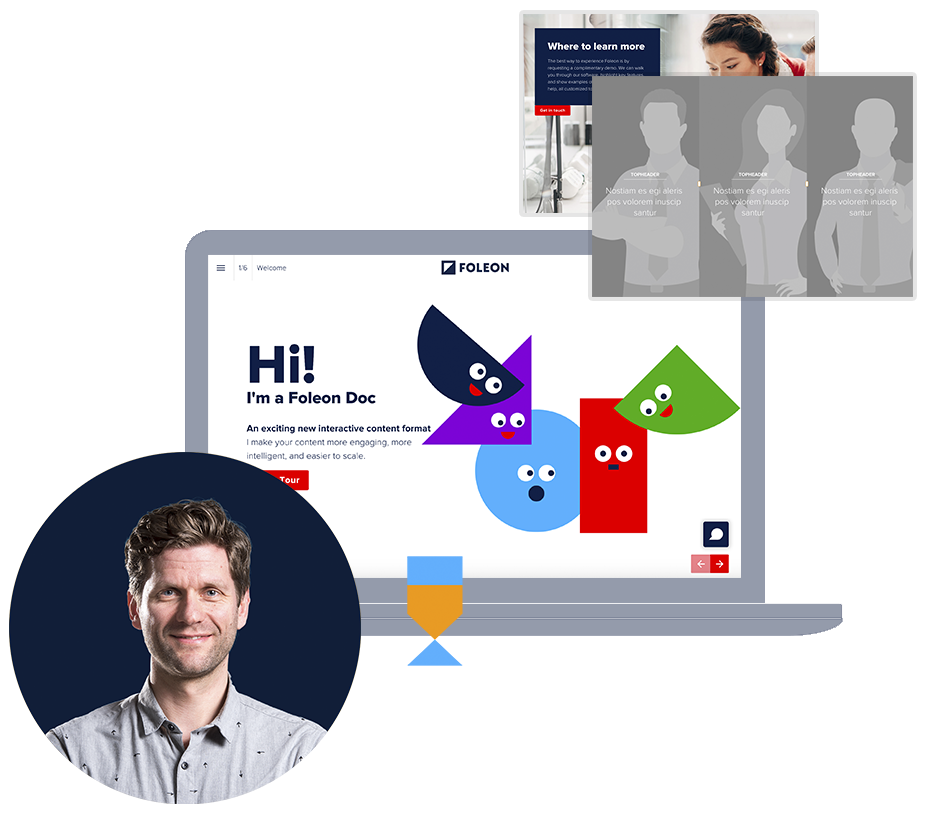When it comes to developing content strategies, many businesses are prioritizing two things: ramping up their content efforts (73%), and improving the visual design of content (51%), according to the Content Marketing Institute.
With such great demand for content, designers want to — and must — stay up to date with the latest tools and trends. However, many worry about remaining relevant with ever-advancing design technology.
Other designers are hesitant about adopting new tools for various reasons, from being restricted to using templated platforms, to changing their workflows and processes.
So, where does this leave creative professionals tasked with staying ahead of the visual content marketing curve?
We sat down with Vincent van der Laan, Creative Director at Foleon, to understand whether modern design tools help or hinder designers.
Hi Vincent, before we kick off, can you give us a bit of background on your professional career?
I studied at the Royal Academy of Arts in the Netherlands and joined a publishing agency shortly afterward. There, I worked on creating magazines for governmental departments and witnessed the transition from print magazines to online, allowing me to push my boundaries creatively.
I eventually moved over to an online agency, where I experimented with platforms that used flash and HTML. I like designing for digital because, unlike magazines, you could navigate the journey for your audience better and create a more interesting content experience for them.
Today, as Foleon's Creative Director, I combine all of that, with the added layer of designing in the Foleon Drag & Drop editor.
Before working at Foleon, what were the main design tools you were using for your projects? Do you still combine them with Foleon?
I typically use Photoshop, InDesign, and Illustrator. When working in Foleon, people often copy their content from a text file, such as Word or Google docs, and then use either stock images or their own graphics created in Photoshop or Illustrator.
In the Foleon Drag & Drop Editor, you can manipulate these images by cropping them or dragging them to become larger or smaller. So these external platforms are still necessary, and I use them in combination with Foleon.

(Image above is a Foleon template used by Vincent for a Marketing campaign).
What do you like most about the Foleon platform and why?
What I like most about the Foleon platform is that we are literally creating everything ourselves, so it really is our thing.
There's a scale of complexity to simplicity, which means that almost anyone, regardless of their design skills, can use Foleon.
I think this is a great middle road for designers because we can spend more time working on complex design projects and simply oversee and facilitate the design for more straightforward projects.
Do you ever find your creativity is affected by using a templated platform? How much creative freedom do you have?
It ultimately depends on the settings you select when using templates. If you are working on a design idea that's quite complex, then using a template is a straightforward approach. For applying particular design elements, you could argue that there are some restrictions, or at least, additional tweaking will be required.
From the perspective of a Marketer or Content Ops professional using this type of platform, it is okay — even good — for them to have creative limits. They need eliminated variables to be successful. Designers, however, need to design smarter and should be enabling Marketing professionals to be successful.
What are the pros and cons of using templates?
The ultimate pro is that templates save a lot of time. When I first started working at Foleon, we couldn't create templates. But if you look at our templates now, they can be saved, managed, and categorized. And as a designer you still have complete freedom; it's up to you to decide how many choices you leave to the other users to make.
Many companies are starting to become more design-centric. Do you think employees should feel empowered to become better design thinkers using modern design tools, or is this best left to professional designers?
This is super interesting. I think with a small push, a lot of marketers could create something by themselves. The question is whether they're willing to spend some time on it and build their design confidence.
For example, when creating an infographic or a new layout, I often see that people still struggle with it. I think in the future, you will still need designers to coach and empower users to use modern design tools, so they will always be required in the creative process.
What would you say to designers who fear being made obsolete with the emergence of modern design tools where anyone can learn to design in a fast and affordable way?
I would tell designers not to be afraid because companies will always need them.
I think designers will be needed even more in the future because a lot more content is being pushed out nowadays compared with ten years ago.
When it comes to the emergence of modern design tools, don't be afraid to accept the challenge, as it means a lot of the nitty-gritty production stuff is taken out of your hands, and that makes design more fun.
A platform like Foleon helps build better designers, not replace them.
We're beginning to see a shift in our industry where we’re becoming enablers and empowering others to help out. I'm trying to become a much more efficient designer these days, and one of the ways I'm doing that is by training the MDR team to create content themselves and come up with a process together to get optimal results.
My advice to you is to be patient and accept the challenges that come your way. You can't keep creating everything by yourself, and that's probably not what you want to do anyway. Focus on becoming that designer who can orchestrate and oversee the entire creative process using modern design tools.


.png?width=382&name=shape1%20copy%20(1).png)
.png)